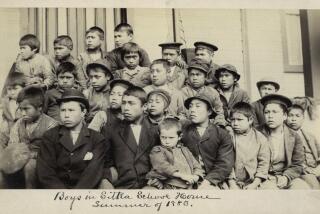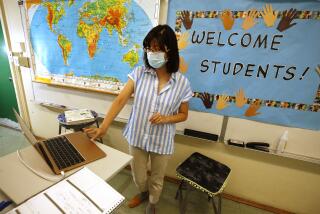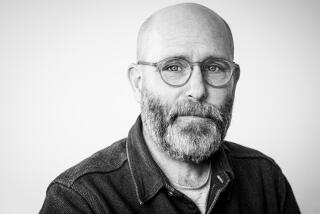It’s an ‘Ordinary’ View of History
Most kids learn in school that the 13 American colonies won their freedom after a bitter war with Britain. But the daily struggles of ordinary people in the ragged Colonial army are sometimes lost when teachers recount the sweeping events of history.
Not so at Oak Avenue Intermediate School in Temple City, where social studies teacher John Lopez recently plunged his eighth-graders directly into the shivering winter of 1777-1778 at Valley Forge. The class read an account from the diary of army surgeon Albigence Waldo of Connecticut, who served in the Colonial army:
“There comes a soldier, his bare feet are seen thro’ his worn out shoes, his legs nearly naked from the tatter’d remains of an only pair of stockings, his breeches not sufficient to cover his nakedness, his shirt hanging in strings, his hair dishevell’d, his face meagre; his whole appearance pictures a person forsaken and discouraged.
“Why are we sent here to starve and freeze?”
Lopez paused to address the class.
“How would you like to be there at Valley Forge?” he asked. “Try going up to the mountains and walking in the snow for six hours in sandals. That’s what these men are going through.”
Later, some students reflected on whether they would have risked hunger, freezing temperatures and even death to defend an abstract concept called liberty.
“If they needed me, I probably would have volunteered, but I wouldn’t want to go through the trouble otherwise,” said Michael Delgado, 14. The teen-ager said he had seen snippets in movies about the Revolutionary War but had no idea how difficult life had been for the soldiers.
“You don’t really realize it until you read about people less fortunate than you,” he said.
Across the room, 14-year-old Alfred Padilla said he enjoyed the eyewitness account more than a textbook recitation.
“It makes you think you’re there,” Alfred said of the surgeon’s account. “It gives you a better description of the truth. You know you’re hearing it from the source, not some company that writes the textbook.”
Darlene Tamanaha and Crystal Reinwald had a different take on ragged soldiers. Asked whether they would have volunteered, they answered brightly that they would not have been eligible to serve in the Revolutionary Army.
Instead, Darlene said, women had to stay home to take care of the house and the children. “They say in the Declaration that we’re created equal, but that was only for white males, that’s what it meant,” Crystal said.
Lopez enjoys stirring the imagination of his students by supplementing text readings with personal narratives. He takes advantage of the new state framework for social studies that seeks to promote a new literature-based, multicultural curriculum.
That’s not to say that Lopez neglects the hefty text, Holt Rinehart Winston’s “The Story of America.” He picks and chooses excerpts and selections from the 966-page tome, which functions more as a teaching tool than an educational bible.
Last week, for instance, Lopez asked his students to open their books to a map listing battles, forts, rivers and cities that figured prominently in the Revolution.
A quiz ensued, in which students asked each other questions based on the map, and the class had to decide whether the answer was correct.
“Who had victory at Germantown?” Crystal asked Mary Rouse. “The Americans,” she responded correctly.
Another recent day, Lopez broke the class into small groups and asked them to write poems about the 13 original colonies. Michael Palfrey, Tamiya Cousins and Michael Delgado came up with the following lines:
Connecticut first became a state
In the year of 1788
The constitution was ratified by Federalists
They used their minds instead of their fists.
Lopez also showed his class a video based on the historical figure John Laurens, the son of a wealthy South Carolina planter who spent the early period of the American Revolution studying abroad in London and being forced to defend Colonial independence to his British friends.
In the video, Laurens struggles to explain how America can demand freedom for its white colonists while keeping black slaves. Eventually, the young man decides to return home to fight in the Revolutionary Army, leaving behind his British friends and his sweetheart, Patty.
After watching the video, Lopez assigned his students to write Laurens a letter expressing their opinions about his decision to come home.
“I want to get them thinking about history in a personal way and to express their opinions about what they know,” Lopez said.
Most students praised Laurens’ decision as brave and patriotic and admired his ability to put his country’s future ahead of his own happiness.
But several raised doubts.
“You could have helped more if you had stayed in England and finished your studies,” Tamiya wrote. “Then you could have helped, not by fighting, but by telling people what was right by using your head.”
More to Read
Sign up for Essential California
The most important California stories and recommendations in your inbox every morning.
You may occasionally receive promotional content from the Los Angeles Times.










